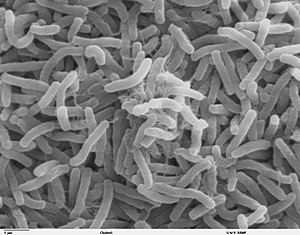Asiatic cholera
| Cholera | |
|---|---|
 |
|
| Scanning electron microscope image of Vibrio cholerae | |
| Specialty | Infectious disease |
| Symptoms | Large amounts of watery diarrhea, vomiting, muscle cramps |
| Complications | Dehydration, electrolyte imbalance |
| Usual onset | 2 hours to 5 days after exposure |
| Duration | Few days |
| Causes | Vibrio cholerae spread by fecal-oral route |
| Risk factors | Poor sanitation, not enough clean drinking water, poverty |
| Diagnostic method | Stool test |
| Prevention | Improved sanitation, clean water, cholera vaccines |
| Treatment | Oral rehydration therapy, zinc supplementation, intravenous fluids, antibiotics |
| Frequency | 3–5 million people a year |
| Deaths | 28,800 (2015) |
| Classification | |
|---|---|
| External resources |
Cholera is an infection of the small intestine by some strains of the bacterium Vibrio cholerae. Symptoms may range from none, to mild, to severe. The classic symptom is large amounts of watery diarrhea that lasts a few days.Vomiting and muscle cramps may also occur. Diarrhea can be so severe that it leads within hours to severe dehydration and electrolyte imbalance. This may result in sunken eyes, cold skin, decreased skin elasticity, and wrinkling of the hands and feet. The dehydration may result in the skin turning bluish. Symptoms start two hours to five days after exposure.
Cholera is caused by a number of types of Vibrio cholerae, with some types producing more severe disease than others. It is spread mostly by unsafe water and unsafe food that has been contaminated with human feces containing the bacteria. Undercooked seafood is a common source. Humans are the only animal affected. Risk factors for the disease include poor sanitation, not enough clean drinking water, and poverty. There are concerns that rising sea levels will increase rates of disease. Cholera can be diagnosed by a stool test. A rapid dipstick test is available but is not as accurate.
Prevention involves improved sanitation and access to clean water.Cholera vaccines that are given by mouth provide reasonable protection for about six months. They have the added benefit of protecting against another type of diarrhea caused by E. coli. The primary treatment is oral rehydration therapy—the replacement of fluids with slightly sweet and salty solutions. Rice-based solutions are preferred.Zinc supplementation is useful in children. In severe cases, intravenous fluids, such as Ringer's lactate, may be required, and antibiotics may be beneficial. Testing to see which antibiotic the cholera is susceptible to can help guide the choice.
...
Wikipedia
